7 Blogging Tips For Ecommerce Fashion Retailers
By Rodney Laws | Ecommerce
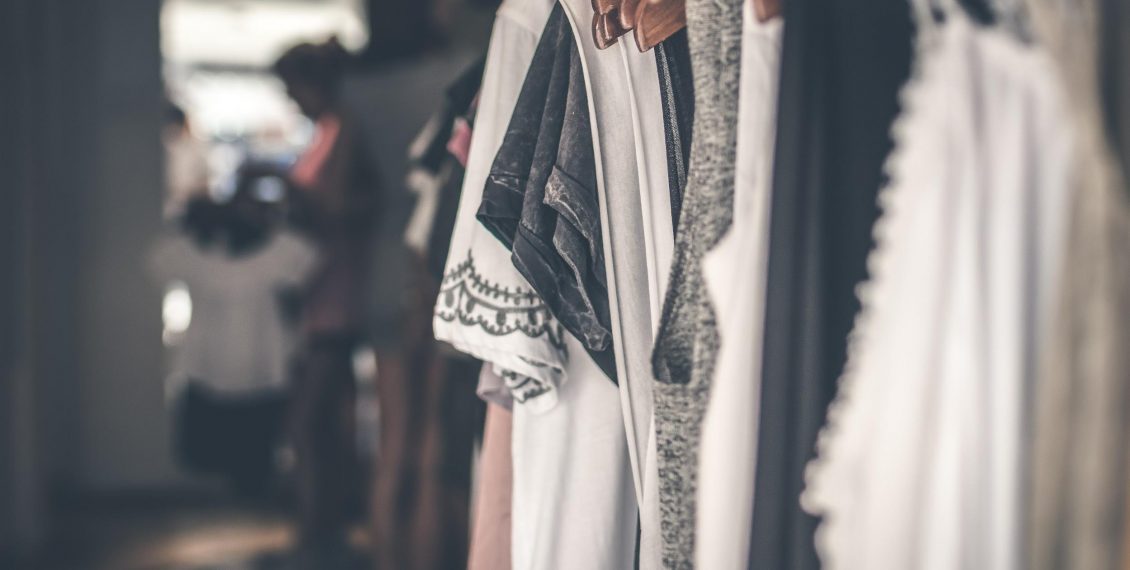
Blogging is at the heart of content marketing strategies for most ecommerce fashion retailers, but there’s a lot of fashion-related content already out there to compete with.
You’re up against some of the biggest retailers out there — not to mention thousands of fashion bloggers, lifestyle bloggers, and influencers. So how can you stand out from the crowd and really make your ecommerce fashion blog shine?
We’ve got you covered. Here are seven blogging tips for ecommerce fashion retailers that will help increase traffic to your blog and improve your engagement with shoppers:
If your ecommerce fashion store has had a blog for a while then you’ve probably done audience research before, but it’s important to keep it up to date.
If you don’t keep revisiting your audience research, then you’re going to end up making assumptions about what they want to read, what they’re interested in, what problems or concerns they’re looking to solve, and what blog content they’re going to engage with.
Ask for regular feedback and talk to your existing customers about why they chose your business, what their main motivations are for purchasing, and what content they want to see.
You can also monitor reviews on your site and on other sites for customer insights that they might not offer up when asked — you’ll be able to spot trends and problems that can inspire your blog posts.
Blogging for ecommerce fashion retailers isn’t as straightforward as writing down some great content and publishing it.
You need to consider the design, layout, and user experience (UX) of your blog (and your website). Taking inspiration from some of the best fashion websites out there can help you to up your game and compete with the best of them.
One of the best examples of a fashion website is Zara. The whole layout is simple and clean, without an overload of products and sales offers — it’s more like looking at a fashion magazine than an online store.
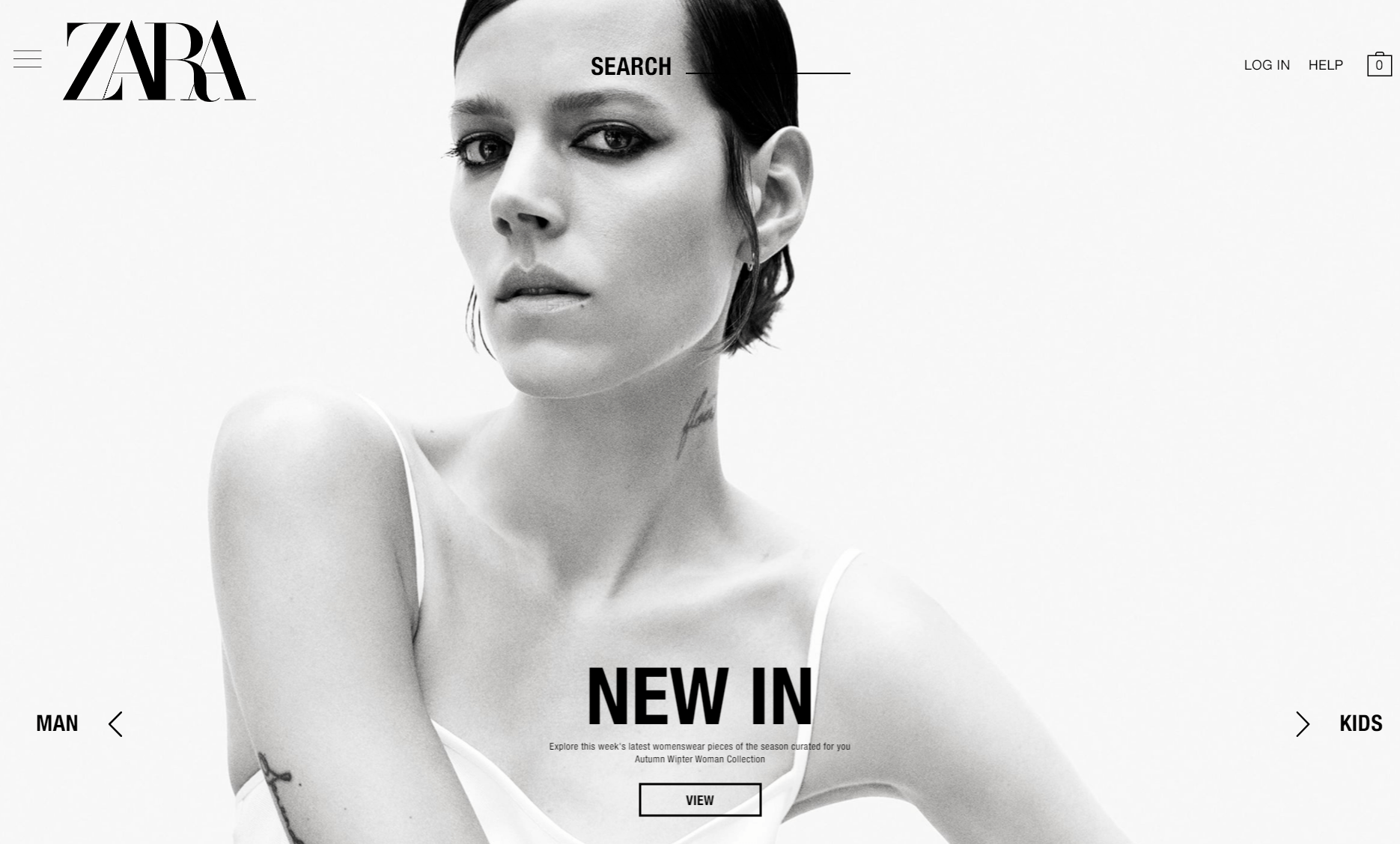
Image: Zara
Wolf and Badger is another fashion retailer that has put together a fully responsive, intuitive website. It’s straightforward to navigate and showcases the full range of products effectively.
The Wolf and Badger blog (Magazine) is a seamless extension of their site, with all their posts set out in a clear, no-fuss layout.

Image: Wolf and Badger
You need to make your blog stand out by using a unique tone of voice and style that fits in with your brand and your products.
Start by thinking about what your brand stands for — what are your values? Why are you selling the products you sell? Focus on your target customers and how you would speak to them.
You can take inspiration from successful independent fashion businesses. Find a few that are selling something similar or targeting a similar market, and follow them on social media, sign up for the emails, and read their blog posts. You want to unpick how they communicate and engage with their readers and loyal customers.
A good example of a strong brand voice is independent fashion retailer, Lucy and Yak. They are known for selling ethically and sustainably made dungarees in a range of bright colours (as well as all sorts of other clothing and accessories).
The website makes it very clear what the brand stands for with a section called ‘What Matters To Us’, which covers their ethos, values, where their fabric comes from, who makes their clothing, and their suppliers. They aim to be completely transparent about how the business operates and their commitment to ethical practices, which is one of the things that really draws ethical consumers to them as a brand.
The Lucy and Yak blog fits in seamlessly with the brand. It’s bright and colourful but covering some difficult topics that align with their values such as fast fashion, racism, mental health, and sustainability.
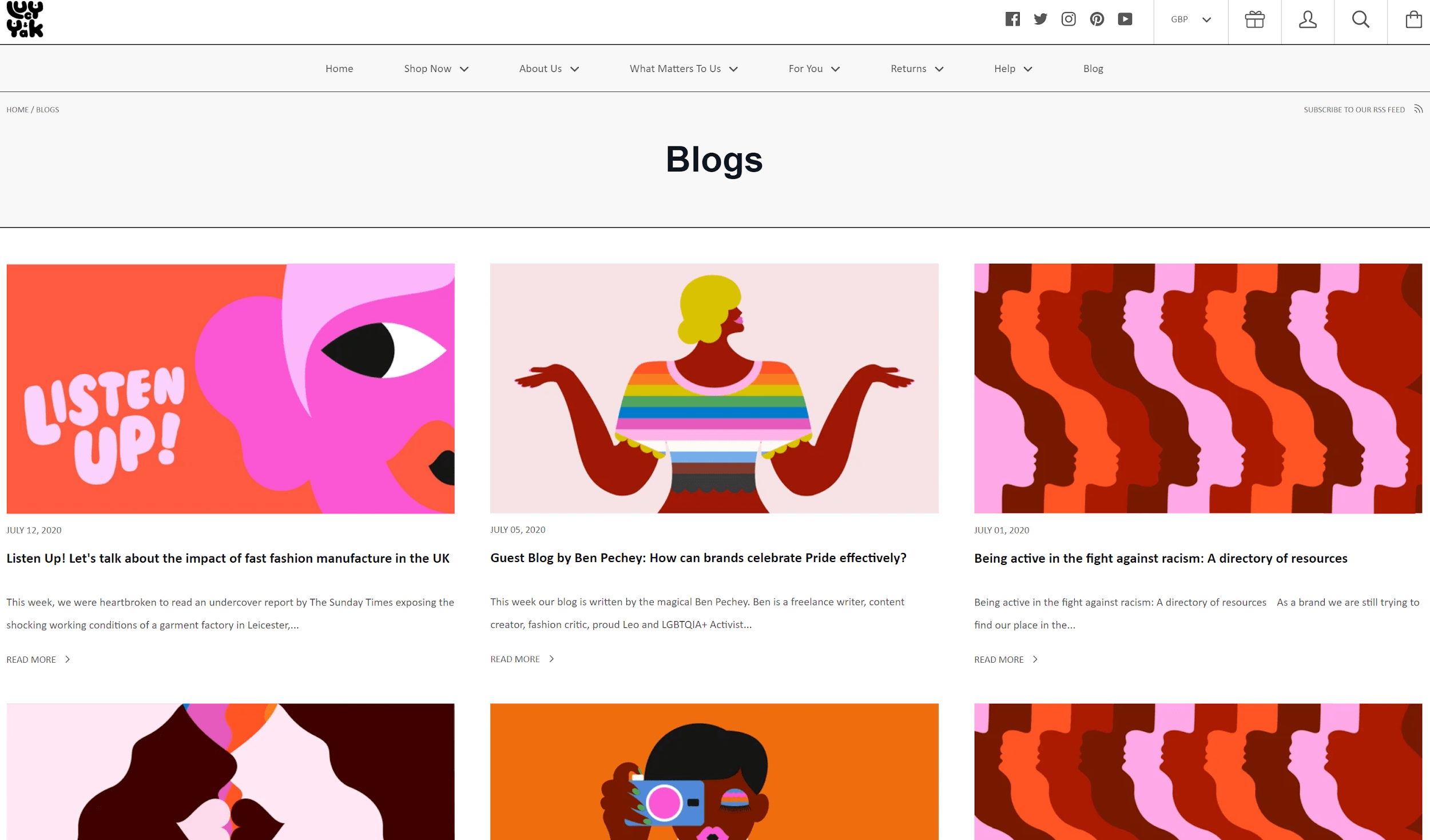
Image: Lucy and Yak
Use your blog to tell a story to your customers and potential customers — it’s an opportunity to share your story and make your store seem more relatable to shoppers.
Consumers look for brands that have meaningful, inspiring stories, and are selling more than just a piece of clothing — they want to buy into the ideals.
For example, Seasalt is a brand that sells clothing inspired by the local area in Cornwall and the sea. Their clothing is colourful but practical, and uses patterns designed by local artists.
Their blog, Seasalt Stories, includes posts about their creative partnerships with artists and talks about how their clothing is designed and made. They also cover charity work, seaside travel destinations, and other content that’s relevant to their target audience such as gardening and home cooking — lifestyle ideals that will really resonate with their audience.
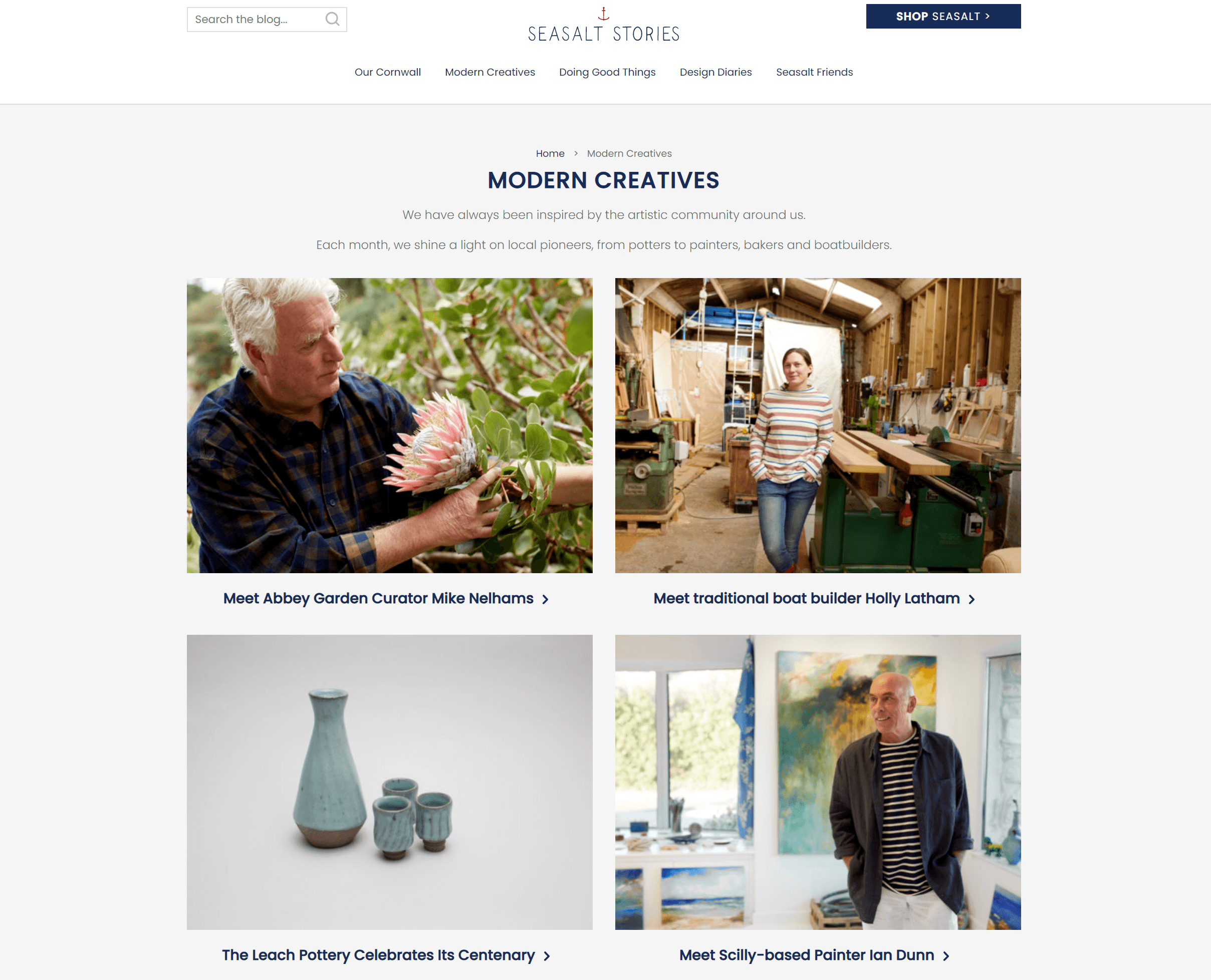
Image: Seasalt
The blog captures the close ties with their local area, their commitment to sustainability, and the story behind the clothing. It gives readers an insight into the company and what goes on behind the scenes, helping them connect with the brand and align themselves with the brand’s values.
Your blog shouldn’t just tell your own company story. You can also use it to share stories from customers, influencers, and celebrities. Your happiest customers — and relevant influencers — can help with brand advocacy and extend your reach.
One of the keys to a successful fashion retail blog is selling a lifestyle, not just focusing on selling your products. You need people to invest in a lifestyle that they can achieve by purchasing your products.
You could start off by finding your ‘best’ customers (either with the most orders, or positive reviews), and reaching out to them about being featured in your blog. Alternatively, monitor your mentions on social media to find brand advocates and influencers that may be interested in working with you.
It’s important to demonstrate how your clothes are worn and used in real life situations. Collaborating with influencers is an important part of ecommerce marketing because it can help you to connect with your target audience, build trust, and convince them to buy. It could even be worth launching an influencer marketing program to drive more traffic to your online fashion shop,
One of the biggest pain points for online fashion shoppers is not knowing how the clothes are going to fit. Using your blog content to address these issues is an important part of convincing readers to convert into shoppers.
Include posts about how different items of clothing will fit — for example, how to find out your measurements for suits or how to pick the right-sized trainers for running. You can also talk about how your range of clothing will fit, and the best way for someone to pick the right style for them.
For example, Levis has a whole page dedicated to explaining their range of jeans. Best of all, they have a Denim Dictionary which covers all their terminology, history, fabrics, and styles:
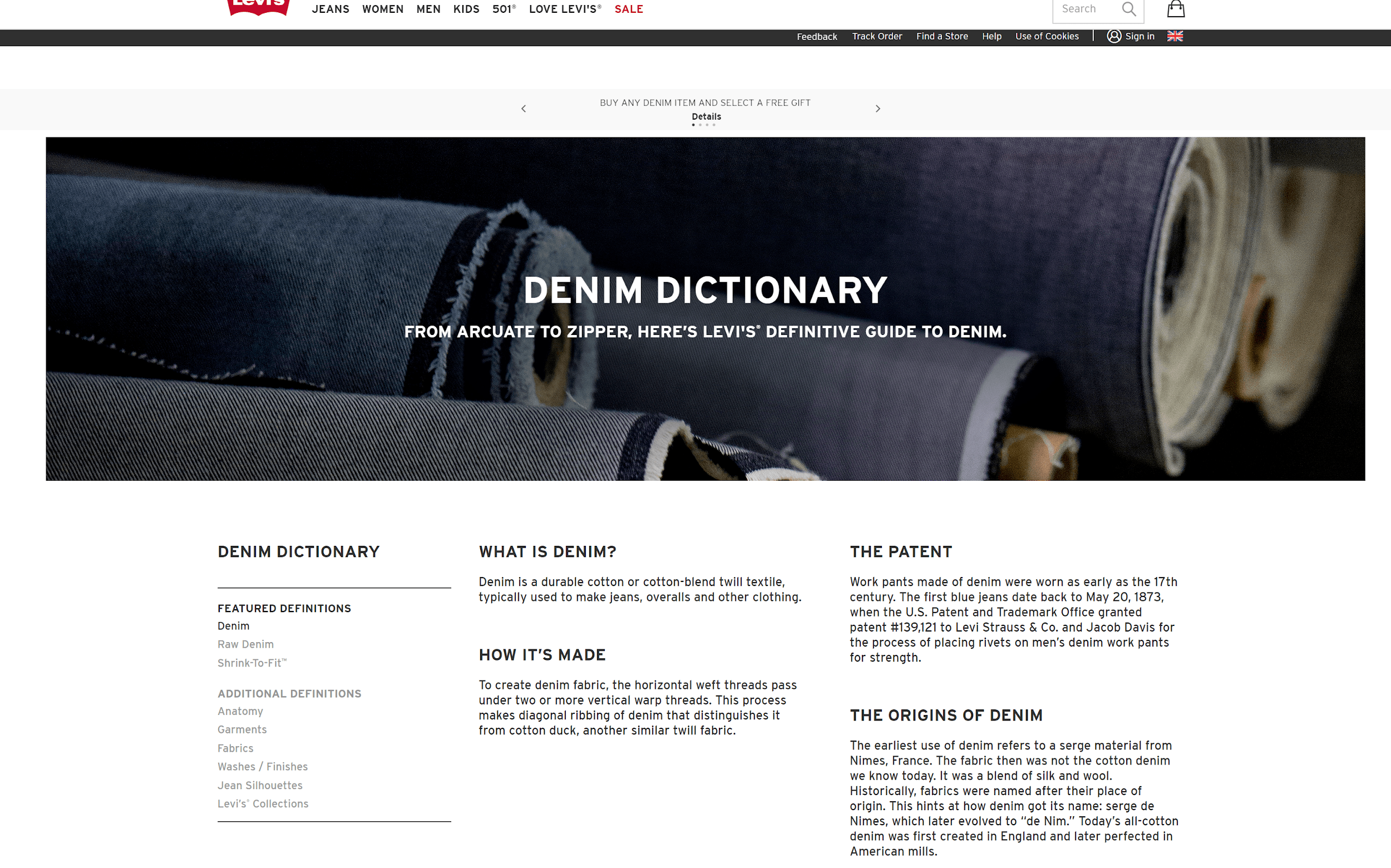
Image: Levi’s
In the last few years, there’s been a spotlight on the pitfalls of the fast fashion industry. There’s much more awareness of the environmental impact that producing different fabrics has, the volume of cheap clothing that ends up going to landfills, and the poor working conditions in factories that make these clothes.
Shoppers now are much more interested in where their clothes come from, how they’re made, and the sustainability of them. They’re trying to move away from buying cheap clothing that’s only worn once, and this is an important conversation for ecommerce fashion retailers to participate in. Beyond this, shoppers are looking for clothing that makes a statement and aligns with their own values and interests.
One of the key topics your blog can cover is the full story of where and how your clothing is made.
This shouldn’t be confused with the specific details you include in your product descriptions. But what your blog post can do is talk about the types of fabric used, whether it’s sustainable or recycled, your manufacturing process, and the people who are making your clothes.
It can also cover insights into the design process and the designers behind the pieces — such as what inspires them to create these clothes, and how they intend for them to be worn.
Style guides, tutorials and other ‘how to’ content is a great way to provide extra value for your customers. By offering useful resources that align with your company, you’re going to be making stronger connections with your target audience, while also promoting your clothes and products.
The ASOS blog is a great example of incorporating ‘how to’ content into an ecommerce fashion blog. Their guides cover putting together outfits for specific occasions, how to customise or update your clothes, makeup tutorials, and guides to buying different products.
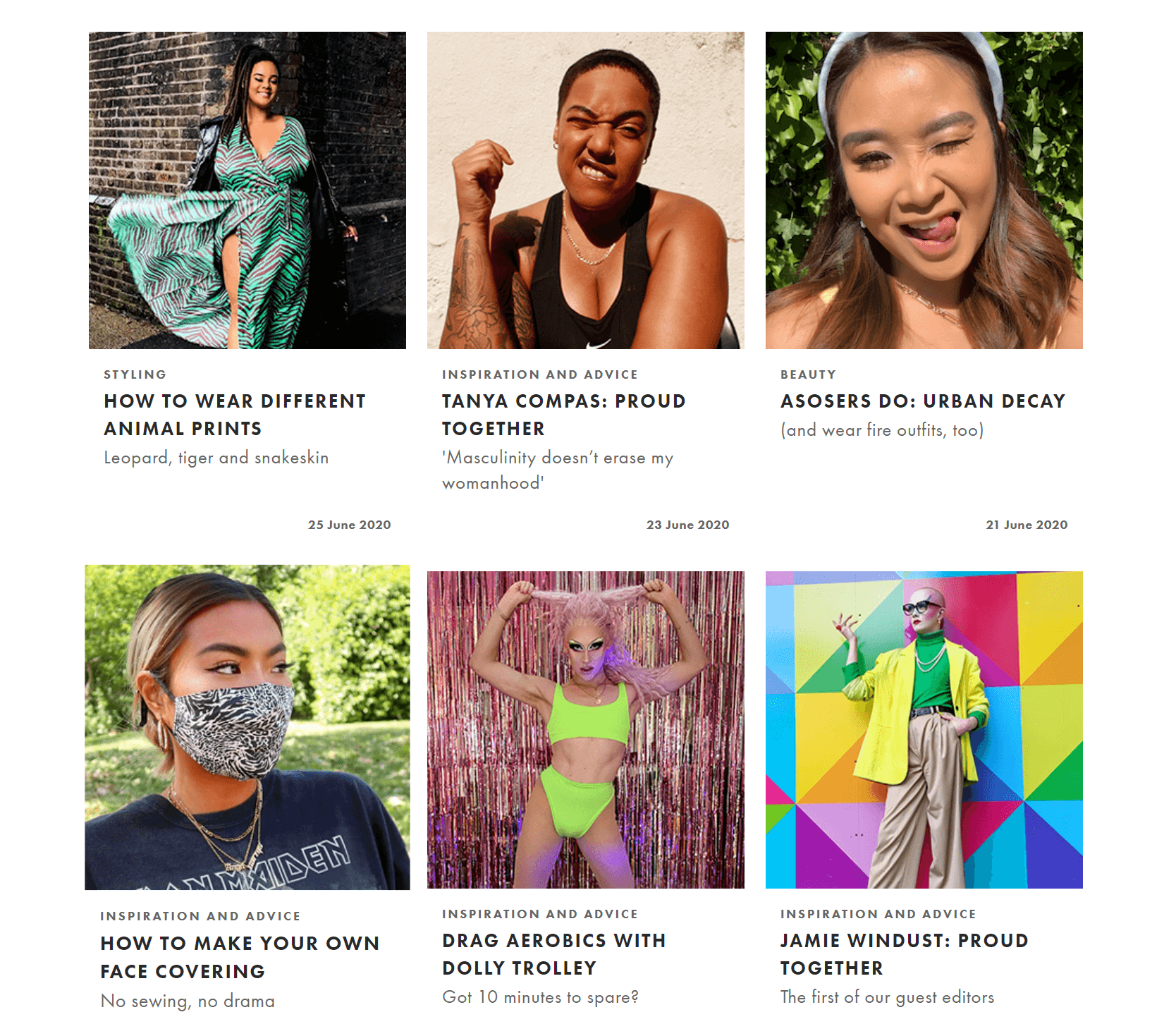
Image: ASOS
They also mix up the format of their blog content with lots of images and videos to keep readers engaged. By providing all this useful content, ASOS are positioning itself as the one place to go for fashion advice and tips — which will hugely increase brand awareness and the reach of their posts.
Blogging for ecommerce fashion retailers relies on a mix of different content that’s all focused on providing a better experience, more value, and creating a real connection between the brand and the customer.
These blogging tips for fashion ecommerce are just some of the ways in which you can engage more with your audience and increase sales. Focus on this, and your ecommerce fashion blog will really shine.